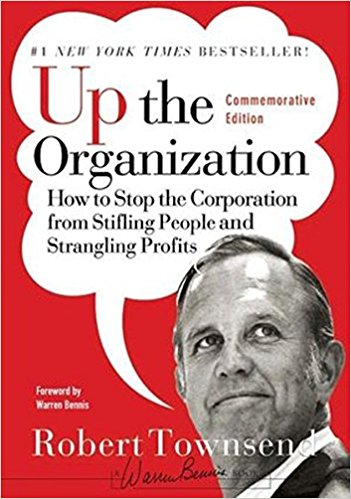Up the Organization Summary

5 min read ⌚
 How to Stop the Corporation from Stifling People and Strangling Profits
How to Stop the Corporation from Stifling People and Strangling Profits
Robert C. Townsend has been described as “a witty and incisive archenemy of corporate bureaucracy.” Unsurprisingly, his 1970 classic, “Up the Organization,” can be best recapped as “a general handbook against bureaucracies of all kinds.”
Read on – for a longer summary.
About Robert C. Townsend
 Robert Chase Townsend was an American businessman and author, most famous as the CEO of “Avis Rent-a-Car” and the author of “Up the Organization.” He transformed “Avis” from a company losing $3 million a year to one that made almost as much. And he explained how he did that in his bestselling book.
Robert Chase Townsend was an American businessman and author, most famous as the CEO of “Avis Rent-a-Car” and the author of “Up the Organization.” He transformed “Avis” from a company losing $3 million a year to one that made almost as much. And he explained how he did that in his bestselling book.
He died from a heart attack in 1998.
“Up the Organization Summary”
In the early 1960s, Douglas McGregor developed a simple theory of human motivation. Or, better yet, two theories: Theory X and Theory Y.
In a nutshell, it claims that there are two different types of people. The X-type is the one who refuses to work until there is some external motivation to do it. The Y-type loves to work for the sake of it, but, in case of strict supervision and rewards systems, feels dissatisfied and betrayed.
Unsurprisingly, the theory resonated in the minds of many leadership thinkers of the time.
However, according to Warren Bennis’ foreword to this commemorative edition of “Up the Organization,” it especially rang true in the mind of Robert C. Townsend, in Bennis’ opinion, “the management guru of the Sixties.”
So, he went on to write this book to explain to people how Theory X organizations are a thing of the past; and what they should do to build a Theory Y company. He should know: he transformed “Avis,” a small company into a “rental car giant”.
And Townsend explains this beautifully in the section “People,” one of the 97 chapters which make up the book. Imagined as a sort of an encyclopedia, the chapters of “Up the Organization” are arranged alphabetically and written in an epigrammatic, entertaining and energetic style which makes for both a educational and laugh-out-loud unforgettable read!
No wonder, Tom Peters once wrote (and he’s among the top, top guys in his profession): “Townsend shouldn’t just be read, he should be memorized.”
Really!
“Up the Organization” is one of those books that can’t be properly summarized. (After all, how do you summarize a dictionary?) And just like any other encyclopedia, it is better off bought and conveniently shelved as a life-long reference.
So, let’s just see for now what is the difference between a Theory X company and a Theory Y organization. Because, making the leap from the former to the latter – is the essence of the book. The book itself is even more engaging and applicable!
Just check out the “Quotes” section!
Anyway, a Theory X company operates on three assumptions:
“1. People hate work.
2. They have to be driven and threatened with punishment to get them to work toward organizational objectives.
3. They like security, aren’t ambitious, want to be told what to do, dislike responsibility.”
This results in obsolete organizational/management structures:
“1. Office hours nine to five for everybody except the fattest cats at the top. Just a giant cheap time clock. (Are we buying brains or hours?)
2. Unilateral promotions. For more money and a bigger title I’m expected to jump at the chance of moving my family to New York City. I run away from the friends and a life style in Denver that have made me and my family happy and effective. (Organization comes first; individuals must sacrifice themselves to its demands.)
3. Hundreds of millions of dollars are spent annually ‘communicating’ with employees. The message always boils down to: ‘Work hard, obey orders. We’ll take care of you.’”
The valid assumptions are the following three:
“1. People don’t hate work. It’s as natural as rest or play.
2. They don’t have to be forced or threatened. If they commit themselves to mutual objectives, they’ll drive themselves more effectively than you can drive them.
3. But they’ll commit themselves only to the extent they can see ways of satisfying their ego and development needs.”
Hence, the Theory Y companies.
They eliminate bureaucracies and put the needs of their employees first. The best among them can choose their own working hours and vacation days: no questions asked! And are never expected to go to waste-of-time meetings.
The leaders of Theory Y companies eat last and have paychecks not much bigger than their workers. And everybody knows this because they are honest and open with information of this kind.
And because they are not only coaches – but players as well.
Key Lessons from “Up the Organization”
1. McGregor’s Theory X and Theory Y People
2. Townsend’s Theory X and Theory Y Organizations
3. Maximize Productivity: Become a Theory Y Organization
McGregor’s Theory X and Theory Y People
In 1957, Douglas McGregor first presented his famous theory of human motivation and management. He developed it further on, but the main idea remained the same.
Namely, that there are two kinds of people: Theory X and Theory Y. The former don’t like work and need a supervisor and an incentive to work well. The latter love work – but if managed strictly will lose their interest.
Townsend’s Theory X and Theory Y Organizations
In “Up the Organization,” Robert C. Townsend makes the case that Theory X organizations stifle productivity. They are labyrinthine bureaucracies with 9-to-5 working hours, unilateral promotions, and failed communication practices.
However, most of the people are Theory Y people. And they strive for something different.
Maximize Productivity: Become a Theory Y Organization
What most people need is a Theory Y organization.
Unlike those old-fashioned Theory X companies, these are not led by fat cats who work less than their employees. Their leaders are philanthropic and open-minded, and consider themselves part of a team. They reward the best members of this team by giving them the freedom to choose their working hours and vacation days.
And, finally, they don’t pay themselves ten times their workers!
Like this summary? We’d like to invite you to download our free 12 min app, for more amazing summaries and audiobooks.
“Up the Organization” Quotes
Don’t hire a master to paint you a masterpiece and then assign a roomful of schoolboy-artists to look over his shoulder and suggest improvements. Share on X Fire the whole purchasing department. The company will benefit from having each department dealing in the free market outside instead of being victimized by internal socialism. Share on X Secrecy is totally bad. It defeats the crusade for justice, which doesn’t flourish in the dark. Share on X Fire the whole advertising department and your old agency. Then go get the best new agency you can. Share on X True leadership must be for the benefit of the followers, not the enrichment of the leaders. In combat, officers eat last. Share on X







